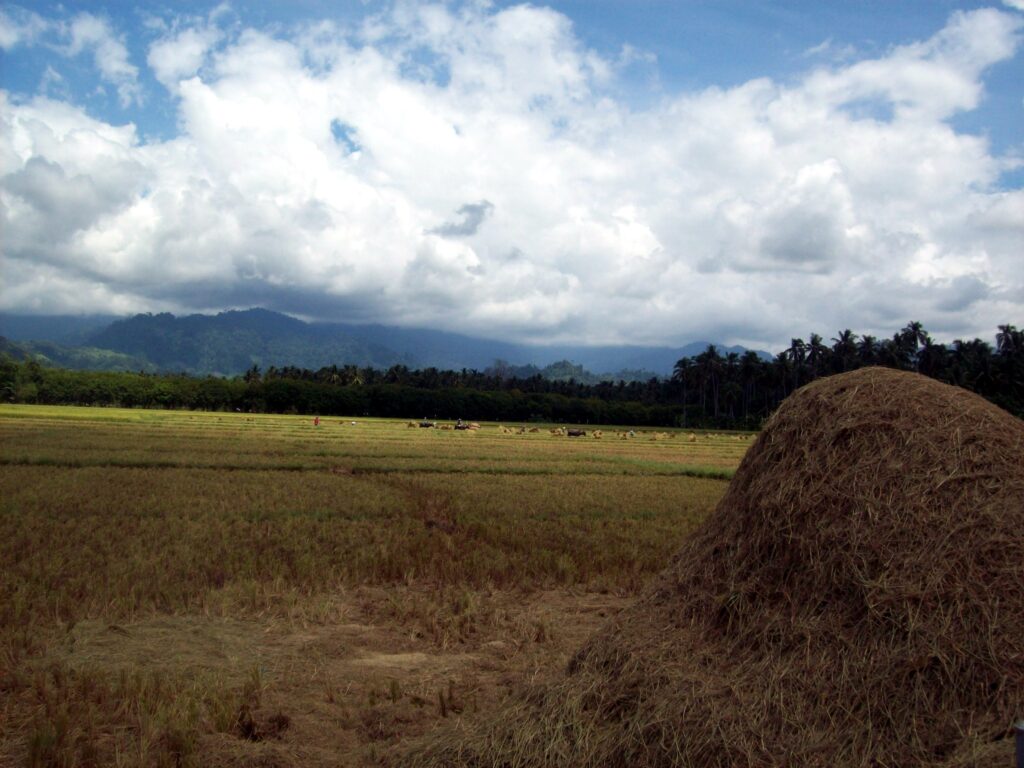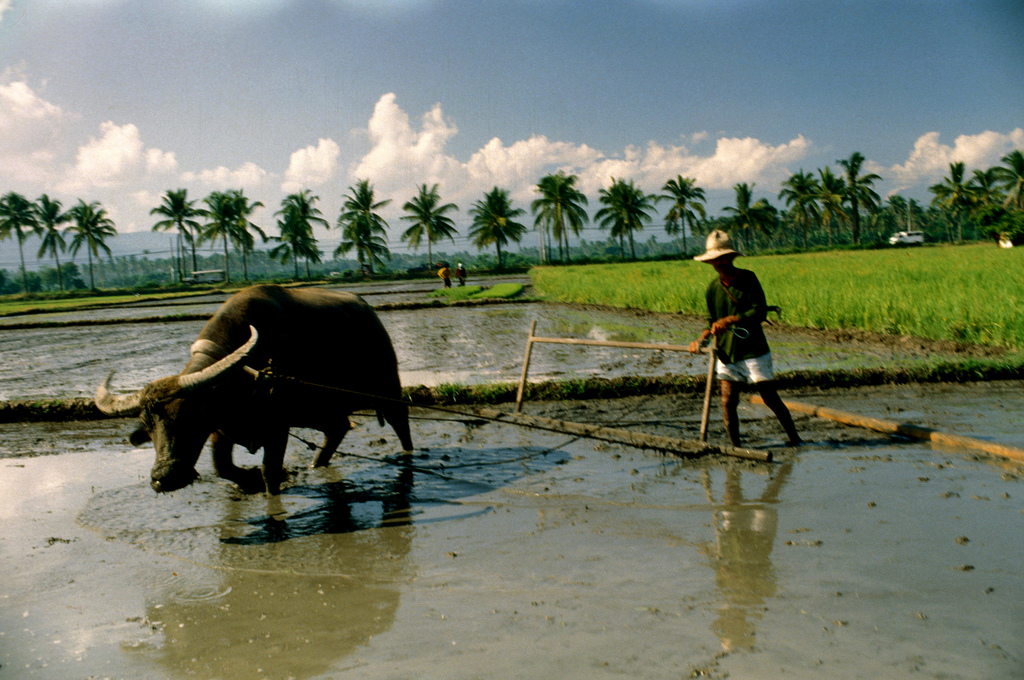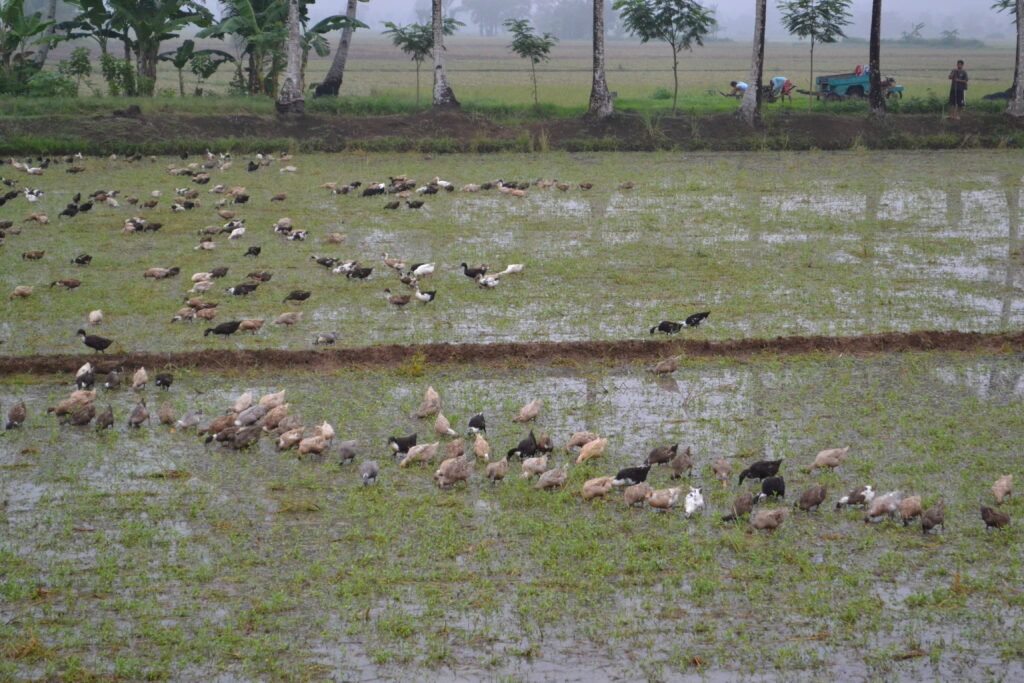Take your pick: Rice farming technologies for methane mitigation
By Henrylito D. Tacio
Farming technologies that can assist in reducing methane emissions into the atmosphere are now available.
The practices of either leaving rice straw in the fields post-harvest or burning it immediately both have significant environmental impacts. The combustion of rice straw generates carbon dioxide, a major contributor to global warming associated with climate change.
Carbon dioxide is classified as a greenhouse gas along with methane, which is produced when rice straw is left in the fields.
“Methane absorbs heat 21 times more than carbon dioxide and it has 9- to 15-year life time in the atmosphere over a 100-year period,” says Dr. Constancio Asis Jr., a recipient of the 2011 Norman E. Borlaug International Agricultural Science and Technology Fellowship Award.
In agriculture, methane is created naturally as a waste product of anaerobic bacteria (living with little or no oxygen). These bacteria produce methane gas in waterlogged soil and wetland, but also in human-produced environments such as rice paddies. Estimates of global methane emission rates from rice fields range from 20 to 100 Tg per year (1 Tg is equal to 1 million tons), according to Dr. Heinz-Ulrich Neue in a paper published in the journal BioScience.

Rice straw biogas
There are two products that come from rice when it is harvested from the field: grain (palay) and straw (dayami). Studies conducted by the Laguna-based International Rice Research Institute (IRRI) showed that for every 4 tons of rice grain about 6 tons of straw are also produced.
Most Filipino farmers consider rice straw as waste as it has little or no commercial value. “Much of this is burnt in open fields or incorporated in the soil in wet conditions during ploughing,” says a policy brief paper published by the Economy and Environment Program for Southeast Asia (EEPSEA).
But there is a better way of getting rid of rice straw and using the methane by converting it to fuel. That is what the Rice Straw Biogas Hub wants to accomplish. It generates biogas as a clean energy source from waste rice straw and offers a comprehensive suite of technological services tailored for rice farmers.
The clean fuel is used for drying the grains and milling thereafter. “We asked farmers and their preference was to use the energy for productive purposes rather than domestic use. So, that’s what we are doing,” explained Dr. Craig Jamieson, a British national whose work has taken him across Africa and Asia developing bioenergy solutions that enhance rather than compete with food production.
Jamieson is the man behind Straw Innovations (SI), Ltd., a United Kingdom-registered group which has established a rice drying service through the combustion of biogas from rice straw.
Drying is the most critical operation after harvesting a rice crop. When rice is harvested, it contains up to 25% moisture. The goal of rice drying is to reduce its moisture content to meet the recommended levels for sale, long-term storage.
“It is important to dry rice grain as soon as possible after harvesting – ideally within 24 hours,” IRRI explained. “Delays in drying, incomplete drying or ineffective drying will reduce grain quality and result in losses.”
But before drying, rice has to be harvested first. Here, the SI introduced a rice harvesting system that it has developed over five years. “The main problems are in getting the rice straw out of the field and to a place where it can be used,” he said.

The likely solution: the 5-in-1 harvesting technology, referring to a machine, which is said to be the first of its kind in the world. “Our machine performs in one pass of the field and performs the five separate operations in conventional straw collection – harvester, chopper, rake, densifier, and collection. It’s more efficient and, critically, it works even in wet conditions (muddy or flooded fields),” Jamieson pointed out.
The collected palay is then brought to another machine where the grain is separated from the rice straw. “At the biogas hub, a dryer dries the rice grain with energy from the rice wastes, another removes the husk and another mills the grain, thus giving the final product,” Jamieson said.
The dryer takes about 12 hours for the grain to dry, Jamieson said. “The technology innovation is to use rice straw to power the process,” he said. “We give farmers the option to retain ownership of their grains throughout the process.
To produce methane in the biogas hub, water is added with the rice straw. The methane gas is a direct substitute for diesel or kerosene in conventional dryers.
“In the past, the government tried to give out free rice dryers but as soon as something broke, the dryers were no longer used,” Jamieson said. “Our business model is to operate our equipment and offer it as a service to farmers. They pay us a service fee but don’t need to buy or operate our equipment.”
During the process, the rice straw gets broken down into fertilizer, which can be used to fertilize the rice. Or it can be applied as organic fertilizer for crops, vegetables and fruits. “It can be used for anything,” he said.
Early incorporation of rice stubbles and straws
Meanwhile, a study headed by Cheryll C. Launio of the Philippine Rice Research Institute (PhilRice) found out that early incorporation of both stubble and straw into the soil is “the most cost-effective way of disposing rice straw.” More importantly, it can help reduce greenhouse gas emissions.
The study – conducted in the rice growing areas of Central Luzon, Western Visayas, Cagayan Valley, and Ilocos regions, where around 30% of farmers burnt their rice straw – showed that the incorporation of stubble within 30 days prior to crop establishment significantly contributes to greenhouse gas (GHG) emissions.
In contrast, incorporating rice stubbles more than 30 days before planting, along with the addition of composted rice straw to the field, resulted in the lowest cumulative emissions of methane and nitrous oxide.
Moreover, transitioning from the conventional method of late stubble incorporation and straw burning to an earlier incorporation of both stubble and straw produced favorable outcomes, achieving a reduction in GHG emissions by approximately 80%. This reduction was primarily attributed to decreased methane emissions.
The conclusion of the researchers: “Shifting from rice straw burning to rice straw incorporation will not necessarily reduce global warming potential if straw is incorporated less than 30 days before cultivation, especially in flooded conditions.”
Duck-rice integration
Rice farmers can also mitigate methane emissions from irrigated rice fields by raising ducks. In this approach, ducklings and ducks are introduced into the rice fields to graze and feed. The movement of the ducks in the water encourages the rice plants to generate a greater number of tillers, potentially increasing annual yields by 10% to 15%.
Most studies conducted on such schemes showed that the continuous activity of the ducks at the bottom of the paddies helps to reduce methane emissions. One of these studies was done by researchers of the regional field office of the Department of Agriculture (DA) in the Cagayan Valley.
Dr. Rafael D. Guerrero III, an academician with the National Academy of Science and Technology (NAST), reported that based on the said study, it was found that there was a “symbiotic relationship” between rice and ducks within the integrated farming system.
The DA researchers said the ducks contribute organic fertilizer through their manure and urine, which supports the growth of rice, while the snails, insects, and weeds present in the rice fields provide natural nourishment for the ducks.
The presence of ducks reduces the labor required for weed removal in the paddies and eliminates the necessity for chemical fertilizers and herbicides. More importantly, the ducks’ activity at the bottom of the paddies leads to a decrease in methane emissions.

Alternate wetting and drying
Another way of reducing methane emissions released into the atmosphere is by adopting controlled irrigation. IRRI, which developed the system, called it alternate wetting and drying (AWD) technology.
AWD is a technology that allows rice fields to dry from a certain period before applying irrigation water. “This technology can actually save farmers almost one-third of irrigation water without sacrificing yield,” IRRI explains. “It also saves farm inputs like oil, fuel, and labor being utilized on the operation of water pumps.”
In AWD technology, rice fields are alternately flooded and dried. The number of days of non-flooded soil can vary from one day to more than 10 days, according to IRRI. It uses an “observation well” that is made of bamboo, plastic pipes, or any hollow indigenous material. Perforations are made in the lower half of the tube.
Studies conducted at IRRI have shown that AWD technology can reduce methane emissions by about 30% or even up to 70%, depending on water usage and management of rice stubble.
Conclusion
The Philippines is among the biggest rice producers. In fact, the country is the 8th largest rice producer in the world, accounting for 2.8% of global rice production. Rice is the staple food for about 80% of Filipinos, the Asian Development Bank reports.
“Rice is a plant that grows best in wet soil, with its roots flooded,” explains L. Hartwell Allen, an American soil scientist at the Crops Genetics and Environmental Research Unit in Gainesville, Florida. “But flooded rice crops emit substantial amounts of methane to the atmosphere.”
“An estimated 19% of the world’s methane production comes from rice paddies,” said Dr. Alan Teramura, a botany professor at the University of Maryland. “As populations increase in rice-growing areas, more rice – and more methane – are produced.”
The journal Science reported that the atmospheric concentration of methane has more than doubled during the last 300 years and is increasing at an annual rate of about one percent each year.
But unlike carbon dioxide, the atmospheric lifespan of methane in the atmosphere is a relatively short 10 to 12 years. “While its lifetime in the atmosphere is much shorter than carbon dioxide, it is much more efficient at trapping radiation,” explains Climate and Clean Air Coalition.

